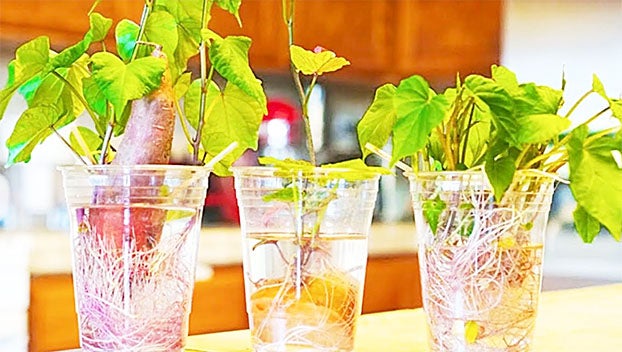TEXAS CERTIFIED EXPERT GARDENER — Enjoy magnificent tubers by growing sweet potatoes
Published 12:10 am Wednesday, May 8, 2024

- An economical option to propagate sweet potato slips is by purchasing sweet potatoes from a local grocery store. Fill a container with water and submerge a portion of the sweet potato in the container. Place the container in a well-lighted, warm area such as a windowsill and wait for slips to grow. (DYIJOY.com)
|
Getting your Trinity Audio player ready...
|
We have experienced torrential rainfall the past few days with some SETX areas receiving more than 20-inches of rain.
Spring weather and climate patterns constantly change, this unpredictability means our living environment can quickly become precarious. Gardening in areas, which have extreme weather, i.e. droughts, floods, or that have extraordinary seasonal temperature fluctuations is challenging for all gardeners (without regard to the gardeners’ experience level).
Last week we discussed the most important step in gardening: soil test. Soil test results provide needed information for gardeners to begin the gardening “journey” and is the critical first step before planting begins.
Gardeners, having clay soil isn’t bad but it does require amendments to be continually added to make the soil friable by increasing soil structure which can make for exceptional gardens! Sweet potatoes need friable soil to provide bumper harvests, so let’s ‘dig’ into today’s topic!
Fun Fact – sweet potato leaves are edible! They are delicious, high in vitamins C and B6 and unlike most other “greens,” thrive in summer’s heat.
Sweet potatoes (Ipomoea batatas), the orange-fleshed varieties are an excellent source of beta-carotene. In North America, we treat them as a warm-season annual.
Ensuring basic soil requirements and growing conditions are met will put you on course for harvesting a bumper crop of sweet potatoes.
There are many varieties of sweet potatoes with a few of the more common types listed which perform well locally. The guidelines provided will assist gardeners correctly prepare beds for sweet potatoes.
Varieties – there are hundreds of varieties, some grown for food others for foliage. The most common food varieties planted in TX are Beauregard (most popular), Centennial, Jewell, and Vardaman. Each of these varieties perform well in our growing environments.
Environment – sweet potatoes enjoy hot days and warm nights, and our SETX weather provides optimal growing conditions. They are extremely heat tolerant but can tolerate light frosts if the soil temperature remains above 55F, though not recommended.
Site selection & Soil Preparation – Full sun and warm days are needed for sweet potatoes. I recommend planting slips on an overcast day in well-drained, sandy loam soil, which is slightly acidic (pH 5 to 7.0). Sandy loam allows the sweet potato to penetrate the soil easily but not remain in an overly moist environment, which often encourages disease or rot.
Soil preparation always begins with a soil test. Determine how much nitrogen (N), phosphate (P), and potassium (K) is needed then add amendments. Some areas have sufficient phosphorus and potassium in the soil.
Incorporate 2 to 3-inches of compost or a complete fertilizer into the soil, as no other fertilizing is needed. Sweet potatoes grow well in mounded beds (8-inches or more) and 4 feet apart or amended raised beds.
Fertilization – a 100-square-foot sweet potato planting area fertilizer requirement is roughly equivalent to: 2 ounces N (nitrogen), 2.5 ounces P (phosphorus), and 2.5 ounces K (potassium). Determining the correct amount of fertilizer to apply divide the number of ounces needed by the percentage in the formulation. For example, if using 13-13-13 fertilizer, the amount of nitrogen required is: 2 ounces ÷ 0.13 = 15.4 ounces of 13-13-13.
Naturally, applying this fertilizer will supply 2 of the 2.5 ounces of phosphorus and potassium needed. A shortfall (difference) can be made up by applying additional amounts of phosphorus and potassium separately, such as using bone meal (0-12-0) for the phosphorus and muriate of potash (0-0-60) which is a source of potassium. Another, simpler approach is to apply 19 ounces of 13-13-13 to get the total amount needed amounts of phosphorus and potassium, noting an extra 4 ounces of nitrogen will be applied.
Watering – every local gardener knows rainfall is often sporadic during the summer months and supplemental watering is necessary, as sweet potatoes require about 20-inches of water. It is vitally important to note that until slips have established strong root systems, they are particularly sensitive to water stress (lack of water) during their first month. My recommendation is to plant slips when days are overcast and to water deeply, then water every other day until well established. Do not water sweet potatoes the final 2 to 3 weeks at seasons’ end to mitigate rot.
Propagation & Planting – there are several ways to plant sweet potatoes with the most propagated form-slips, or as some local gardeners call them “vine cuttings”. Slips can be purchased at home & garden stores or ordered from online merchants. A more economical option (this is my favorite option) is to grow the slips yourself. Purchase a healthy sweet potato from a local grocery store.
Suspend sweet potato in a glass of water using bamboo skewers inserted into sides of the potato, submerging the bottom third of the sweet potato in the water. Place the sweet potato in a window and watch with joy, over the next several weeks slips will begin to grow, that can easily be removed and planted in prepared beds. Sweet potatoes typically produce 6 to 8 slips per potato.
The best time to plant is when the measured soil temperature is over 65°F (planting depth) in the spring having 5 months (150 days) before anticipated 55°F soil temperature in the fall. It is important to ensure beds remain weed free until the vines have completely covered the soil surface as this drastically improves harvest quantity and quality.
Diseases & Pests – there are a few known diseases and insects which enjoy ‘snacking’ on sweet potatoes which are: leaf spots, nematodes, beetles, cutworms, and weevils.
Harvesting – the tuber (root) has a delicate skin which is bruised easily at harvest. Take your time when harvesting and be careful not to bruise the tubers with when using shovel, spade, or garden fork. The optimal time to harvest sweet potatoes is immediately before or after the first frost. Allow sweet potato leaves turn yellow, which signals growth has stopped and the roots have matured.
Let’s go out and grow ourselves a greener, more sustainable world, one plant (or sweet potato) at a time!
Send Certified Texas Expert Gardener John Green your questions and please continue sending comments to jongreene57@gmail.com.





